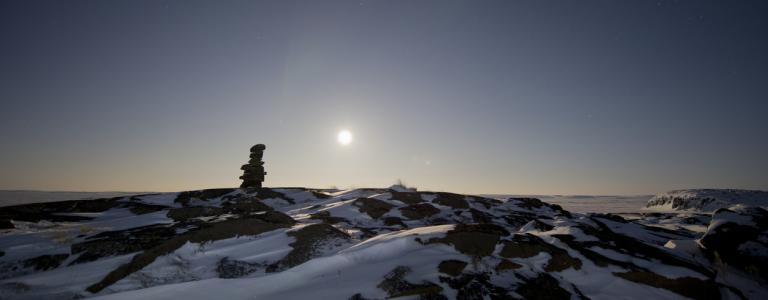Indigenous Protected Areas, a Way to Meet Human and Environmental Challenges?
This commentary examines Indigenous Protected Areas (IPAs) and their growing importance in recognizing the rights of indigenous societies and safeguarding biological diversity.
Internationally, the concept of Indigenous Protected Areas (IPAs) is a subject matter of growing importance in recognizing the rights of indigenous societies and safeguarding biological diversity.
There is no single definition for an IPA, and there are many similar terms that are often used interchangeably. Regardless of the words used or term applied, the most important characteristic of an IPA in this context is that it prioritizes the long-term health and protection of nature. Mary Simon, in her recent report, A New Shared Arctic Leadership Model, described these basic principles:
“IPAs are based on the idea of a protected area explicitly designed to accommodate and support an indigenous vision of a working landscape. This kind of designation has the potential to usher in a broader, more meaningful set of northern benefits and bring definition to the idea of a conservation economy.”
However, no country in the world has a clear statute that explicitly includes or codifies an IPA.
In Canada, one could argue there are already sufficient legal and policy frameworks in place for Canada to be a world leader in recognizing and forming IPAs. This context includes, but is not limited to, section 35 of the Constitution Act, the Truth and Reconciliation Commission’s Call To Action, the United Nations Declaration on the Rights of Indigenous People, the Paris Climate Agreement, and signed and yet to be signed treaty agreements.
Around the world, the designation and qualification of IPAs are contextually sensitive and informed by many factors, including: distinct histories and development of indigenous stewardship, diverse experiences and relationships between indigenous peoples and post-colonial powers, and unique evolutionary, human and environmental factors that have led to the social and ecological landscape we see today. Case study examples from Australia, Brazil, New Zealand and Ecuador provide useful opportunities for answering the questions: What do international examples of IPA designations have in common? What innovative economic and stewardship programing exists? Is there a relationship between promoting indigenous culture and language and protection of nature? What obstacles are facing IPAs?
In Australia, the government defines an IPA as, “voluntarily dedicated by Indigenous groups on Indigenous owned or managed land or sea country.” IPAs are considered a significant part of the country’s National Reserve System and conservation system by contributing to Indigenous protection of biodiversity.
Brazil’s Xingu River basin hosts over 25,000 indigenous peoples coming from more than 18 unique ethnic groups such as the Juruna, Xikrín, Arara, Xipaia, Kuruaya, Parakanã, Araweté, and Kayapó. Here, the territories are designated as "indigenous lands and protected areas" (ILPAs) and co-exist along the arc of deforestation occurring in the Brazilian states of Mato Grosso and Pará. Research in this region has found that support for indigenous communities and traditional stewardship has the capacity to lead to innovative public policy that may contribute both to scalable resource management and income-generation within the ILPA areas.
New Zealand’s Māori tribe of the Tūhoe people have had a tense relationship between government-driven protected area processes and the recognition of their land rights. This circumstance has created the mutually beneficial context to pursue shared governance and territorial management.
Ecuador’s Cofan nation has similarly faced the tense relationship between recognition of land rights, land ownership and the need for environmental management. Situated between the Cofan Bermejo and the Cayambe-Coca Ecological Reserves is an ecological passage that contains a high degree of endemic species, biodiversity and flow of environmental processes. This area also forms a part of the Cofan nation’s ancestral territory, but had fallen outside of the lands formally adjudicated to them. As a result, tension has arisen where the Cofan nation have been unable to manage threats to the natural environment from exploitation. In response, they have sought methods of land acquisition and co-management solutions between the Cofan people and Ecuador’s Ministry of Environment.
Further work needs to be done to analyze how well these, and other, designations are working and if they are achieving their objectives. In the midst of Canadian federal government’s commitment to a renewed Nation to Nation and Inuit to Crown relationship, this is the moment to explore IPAs as innovative new thinking that offers a pathway to meeting our moral and constitutional obligations in step with protecting our natural heritage.
You might also be interested in
G20 Finance Ministerials and World Bank/IMF Spring Meetings: Expert comment
G20 finance ministerials and World Bank/IMF spring meetings will take place this week in Washington. High on the agenda is the need to mobilize trillions of dollars of investment in the transition to clean energy.
IISD Applauds Canada’s Reaffirmation to End Domestic Public Finance for Fossil Fuels in Budget 2024
Today's federal budget announcement delivers new measures to support affordability and reaffirms Canada’s commitments on climate action.
South Africa Fossil Fuel Subsidies Top $6 Billion, Study Shows
South Africa's fossil fuel subsidies rose to a 118 billion rand ($6.3 billion) in the 2023 fiscal year, providing incentives that encourage their continued use, according to a Canadian think tank. Government support for oil and gas consumption, electricity that's largely generated from coal, and carbon tax exemptions has tripled since 2018 in Africa's most industrialized nation, researchers at the Winnipeg-based International Institute for Sustainable Development wrote in a report published Tuesday.
South African Fossil Fuel Subsidies Hit Record Highs as Country's Energy Crisis Deepens
South Africa's fossil fuel subsidies tripled between 2018 and 2023, hitting USD 7.5 billion, up from USD 2.9 billion 5 years earlier, a new report by IISD reveals.
